Newport to Poole/Bournemouth (2 days riding 120 miles +1 day chilling)
Poole has always had a special place in our memories, so we came up with the outlandish idea of riding there. During my competition years, we’d ride 120 miles on a Sunday club run, but today, older and fatter, it wasn’t possible, was it? In 2013, something clicked and it became a mission. We decided to do it over two days and stay an extra day in Bournemouth. We trained as hard as our busy lives would allow. Sadly, one week prior to the ride, my mates mum passed away. Bravely, he decided to continue with the ride as the funeral was due two weeks after we were back. The trip now became more than a ‘wouldn’t it be good to do it’, it became a must. So here it is; a quest that has been in the making for some thirty years.
Day 1- Newport to Warminster (60 miles)
We met on the main Chepstow road out of Newport, it was overcast, and dull, and at -5°C, it was one of the coldest days on record, but it wasn’t damp, it was a dry cold. Other parts of the country were submerged in record low temperatures. We looked at each other and thought, ‘do we really want to do this today?’ But neither of us said it, so off we went, and in truth I feel if we hadn’t gone ahead, we would never had done it at all. I had encountered cold conditions in training before, but the biting cold was beyond my experience. We both had two sets of leggings on and had enough layers to keep us warm, though the wind chill was way below what we’d expected. I popped into a news agent and bought a paper, not to read, but put down our chests (an old trick used when going down long descents).
 When we got to the Seven Bridge, the wind was even stronger; we ducked behind the bridge
walls to evade the cold. On the other side of the bridge it felt like my face had been prodded
with a thousand pins. We rode to the services at Aust and had a hot tea, if someone had offered me a
lift back home; I would have accepted, but on we went. We traveled through the lanes of Olveston heading
to Almondsbury. We were skirting the edge of Bristol, Britain's first ‘cycling City’, a title given by
the government in response to millions of pounds in grants to make dedicated cycling lanes (but where are they?). We headed
for Bradley Stoke where there were shared pedestrian and cycle paths, but at each roundabout it was a ball
ache getting across the road to the next. Once at Hambrook traffic lights, we crossed the busy dual carriageway
and joined the cycle path that follows the ring road all the way to the Bristol to Bath cycle path.
When we got to the Seven Bridge, the wind was even stronger; we ducked behind the bridge
walls to evade the cold. On the other side of the bridge it felt like my face had been prodded
with a thousand pins. We rode to the services at Aust and had a hot tea, if someone had offered me a
lift back home; I would have accepted, but on we went. We traveled through the lanes of Olveston heading
to Almondsbury. We were skirting the edge of Bristol, Britain's first ‘cycling City’, a title given by
the government in response to millions of pounds in grants to make dedicated cycling lanes (but where are they?). We headed
for Bradley Stoke where there were shared pedestrian and cycle paths, but at each roundabout it was a ball
ache getting across the road to the next. Once at Hambrook traffic lights, we crossed the busy dual carriageway
and joined the cycle path that follows the ring road all the way to the Bristol to Bath cycle path.
The Bristol to Bath cycle path is the oldest 15 miles of the National Cycle Network and runs along the old Midland Railway’s Mangotsfield to Bath branch Line. The path is all asphalt and relatively flat all the way to Bath, we were due to stop at Warmley, where the station had been converted to a cafe. There we’d warm up again and wait for another friend, who was going to ride all the way to Bath with us. When we arrived, the cafe was shut and our friend was late. To combat the cold, I rode up and down the same path, turning around every hundred yards. Just to add to the freezing conditions, I had a front puncher and when I took my gloves off, the dexterity in my hands drifted away. It took fifteen minutes to change the inner tube, and then our friend arrived. We continued on and it was a pleasure to have a fresh person to talk to, over the months training with my best mate, we’d grown tired of each other’s conversation.
 At Bitton we crossed the tracks of the Avon Valley Railway and headed for the cafe on the
restored station, then suitably refreshed pushed on to Bath. Route 4 of the National cycle route
goes all the way to Bath then ends at the river Avon. We crossed over the river and headed for
another cafe for a cup of tea, I truly believe if we hadn’t stopped every ten to twenty miles to have a
brew, we wouldn’t have been able to continue. We headed for Linear park towards the two
tunnels route, but I hadn’t done my research properly and they were shut, forcing us to make a
diversion around the route. We managed to get on the B3110 out of Bath and it just kept climbing
and climbing (that’s why the railway built a tunnel) all the way to Midford.
At Bitton we crossed the tracks of the Avon Valley Railway and headed for the cafe on the
restored station, then suitably refreshed pushed on to Bath. Route 4 of the National cycle route
goes all the way to Bath then ends at the river Avon. We crossed over the river and headed for
another cafe for a cup of tea, I truly believe if we hadn’t stopped every ten to twenty miles to have a
brew, we wouldn’t have been able to continue. We headed for Linear park towards the two
tunnels route, but I hadn’t done my research properly and they were shut, forcing us to make a
diversion around the route. We managed to get on the B3110 out of Bath and it just kept climbing
and climbing (that’s why the railway built a tunnel) all the way to Midford.
 At Midford we crossed the Bath to Radstock cycle path and decided to continue on the road.
Hindsight is a wonderful thing, the road had loads of blind bends and was dangerous all the
way to Hinton Charterhouse. We continued on to Norton St. Phillip and had another tea in the
George Inn, an 18th century Tudor coaching Inn. After which we parted company with our guest
and continued on through Woolverton, and Beckington. At Standerwick, we crossed over the main railway
line and saw in the distance the chalk outline of a horse cut into the hillside. It was with great
relief when we turned the corner and saw the Travelodge at Warminster.
At Midford we crossed the Bath to Radstock cycle path and decided to continue on the road.
Hindsight is a wonderful thing, the road had loads of blind bends and was dangerous all the
way to Hinton Charterhouse. We continued on to Norton St. Phillip and had another tea in the
George Inn, an 18th century Tudor coaching Inn. After which we parted company with our guest
and continued on through Woolverton, and Beckington. At Standerwick, we crossed over the main railway
line and saw in the distance the chalk outline of a horse cut into the hillside. It was with great
relief when we turned the corner and saw the Travelodge at Warminster.
The nearest place to eat was the Little Chef next door and we couldn’t be bothered to go into town. I will never eat in a Little Chef again (I've said this before), I mean what more did I expect? We both spent on average £28, it tasted like pre-packed freezer food, deep fried, and bland. No fault of the minimum waged staff, they were doing their job. We retired back to the Travelodge and just went to bed and watched TV.
Day 2- Warminster to Poole/Bournemouth (62 miles)
The forecast promised warmer weather than yesterday, and when we stepped out from the
Travelodge, it didn’t feel that way. With the absence of a cycle path from Warminster we
headed up the A350, an extremely busy road with fast moving traffic, whilst climbing we had
a run in with a white van. He overtook us at speed and underestimated the distance of the
oncoming traffic, almost causing a collision. This was to be the norm, as traffic passed too
close for comfort.
 At Shaftsbury we gladly turned off the main ‘A’ roads, onto the back roads.
We climbed again on the B3081, over Cranborne Chase, an area of outstanding beauty 500 feet above
sea level, but it seemed higher. At Larmer Tree Gardens, we were lucky it was open and rode up
the drive to have another tea. We continued on Millers lane and crossed the A354, the views were
outstanding, and turned right onto the B3078. Through Stanbridge, Clapgate, Walford, and into
Winbourne Minster.
At Shaftsbury we gladly turned off the main ‘A’ roads, onto the back roads.
We climbed again on the B3081, over Cranborne Chase, an area of outstanding beauty 500 feet above
sea level, but it seemed higher. At Larmer Tree Gardens, we were lucky it was open and rode up
the drive to have another tea. We continued on Millers lane and crossed the A354, the views were
outstanding, and turned right onto the B3078. Through Stanbridge, Clapgate, Walford, and into
Winbourne Minster.
Wimborne Minster is a market town in Dorset, and is situated at the confluence of the River
Stour and River Allen. It’s a posh town and there are no true greasy spoon cafes, just Bistros and
wine bars. We decided to go in the ‘Number 9’ restaurant and I have to say, two sweaty cyclists were
welcomed with open arms. We had toasted tea cakes and of course tea. We left Windborne and climbed
gravel hill on another busy ‘A’ road. Then we turned off the road and onto a shale track which used
to be part of the Southampton and Dorchester Railway, turning off onto Broadstone way. We could now
smell the sea as we rode along ‘Holes Bay’, a natural estuary leading to Poole.
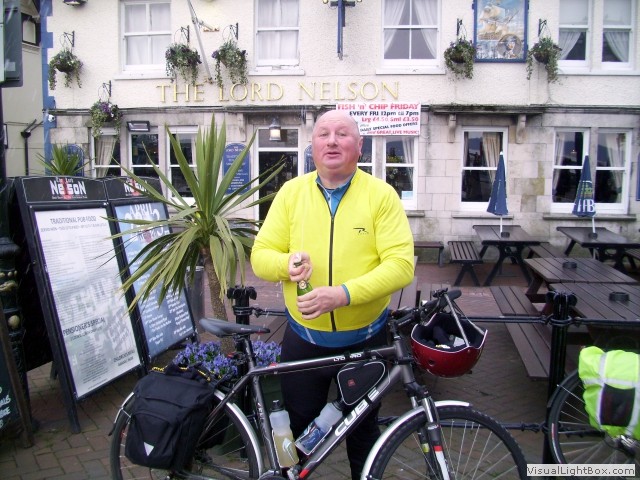 From here we made our way to the Quayside to the ‘Lord Nelson’ pub, this pub was the true end
destination of the trip and we celebrated with a small bottle of Champaign. We still had to ride
to Bournemouth to our hotel (we decided to stay in Bournemouth as the hotels were cheaper). The
path took us through ‘Bater Park’ which goes around Parkstone Bay. At sandbanks (a very expensive
area of Poole) we followed the coast to Bournemouth and left the under cliff drive at the pier,
climbing to the hotel.
From here we made our way to the Quayside to the ‘Lord Nelson’ pub, this pub was the true end
destination of the trip and we celebrated with a small bottle of Champaign. We still had to ride
to Bournemouth to our hotel (we decided to stay in Bournemouth as the hotels were cheaper). The
path took us through ‘Bater Park’ which goes around Parkstone Bay. At sandbanks (a very expensive
area of Poole) we followed the coast to Bournemouth and left the under cliff drive at the pier,
climbing to the hotel.
We booked into the ‘Elstead hotel’ the cheapest hotel I could find in Bournemouth that had a pool. Dripping with sweat and dressed in cycling gear, the receptionist asked me the registration of my car, which had my mate and me in fits of laughter. Still the receptionist didn’t understand, until we pointed out we were on our bikes. The rooms were spacious and tastefully decorated, we showered and went down for a swim and a pint. We were recommended eating at ‘Days’ restaurant, a £16 all you can eat, with every combination of food imaginable. We’d never been to such an establishment, it was great.
Day 3- Bournemouth to Swanage (bus)
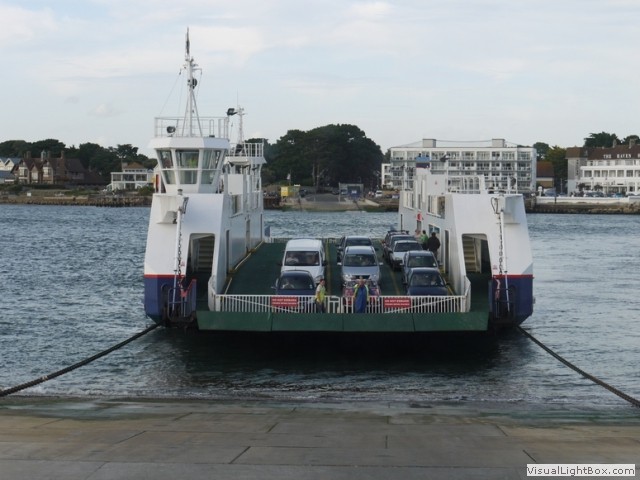 The bus station was just around the corner from the Elstead hotel, so now suitably rested we decided
to visit Swanage. I knew we had to use a ferry crossing the entrance to Poole Harbour between
Sandbanks and Swanage. What I didn’t know is the double Decker bus goes onto the ferry and continues
on the other side. So none the wiser, we disembarked the bus and boarded the ferry by foot, we paid
£1 each as foot passengers. Once I saw the bus was allowed onto the ferry, we tried to re-board the
bus but weren’t allowed, as no one on foot is permitted to be on the car deck whilst the ferry crosses.
We were told we will have to re-board the bus at the next bus stop on the Swanage side. The only problem
was; the Swanage side bus stop was at least three hundred yards away from the dock. We had to sprint to
catch the same bus we were previously on.
The bus station was just around the corner from the Elstead hotel, so now suitably rested we decided
to visit Swanage. I knew we had to use a ferry crossing the entrance to Poole Harbour between
Sandbanks and Swanage. What I didn’t know is the double Decker bus goes onto the ferry and continues
on the other side. So none the wiser, we disembarked the bus and boarded the ferry by foot, we paid
£1 each as foot passengers. Once I saw the bus was allowed onto the ferry, we tried to re-board the
bus but weren’t allowed, as no one on foot is permitted to be on the car deck whilst the ferry crosses.
We were told we will have to re-board the bus at the next bus stop on the Swanage side. The only problem
was; the Swanage side bus stop was at least three hundred yards away from the dock. We had to sprint to
catch the same bus we were previously on.
It was a pleasant ride to Swanage on the open top bus, once there we went to the pier. Swanage's Victorian pier is over 100 years old and is one of two built, although it is the only one that survives complete today. The pier extends into the southern end of Swanage Bay. It was being renovated when we walked the boards, but was still quite impressive.
Next on our list was Swanage railway; The route to Swanage Railway was a branch line from near Wareham, it opened in 1885, and the independent company that built it, was amalgamated with the larger London and South Western Railway in 1886. For some reason passenger services were withdrawn in the early seventies, I was told by one of the volunteers; it took ten months to rip the line and infrastructure up and fifteen years to put it all back as a heritage railway. They even had to buy the station back from Taxi Company.
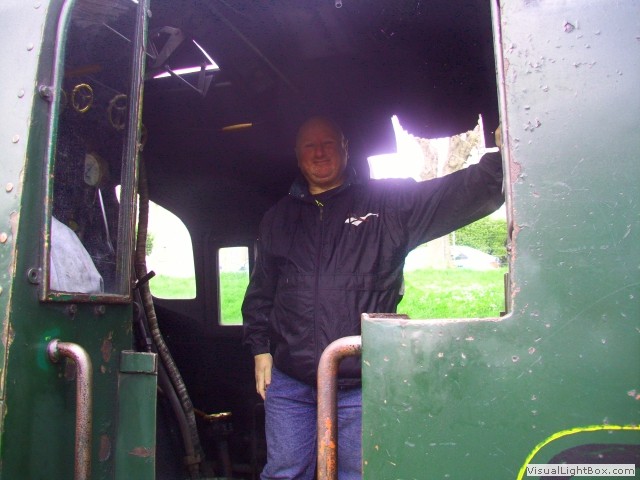 When the engine came in to the station, the driver got off and as luck would have it, the fireman
allowed us on to the footplate, something which I had never done (click the image for more). When we were ready to leave the
station, we went to our carriage. The scenery was good, but the pinnacle of the trip had to be Corfe
Castle. Shaped by wars long forgotten, Corfe Castle is a thousand year old Royal castle, one of Britain's
most iconic and evocative survivors of the English Civil War. There was no need to leave the coach as the
castle was easily seen from the windows. With smoke in our eyes, we returned to Swanage and caught the bus
back to Bournemouth (this time we stayed on the bus).
When the engine came in to the station, the driver got off and as luck would have it, the fireman
allowed us on to the footplate, something which I had never done (click the image for more). When we were ready to leave the
station, we went to our carriage. The scenery was good, but the pinnacle of the trip had to be Corfe
Castle. Shaped by wars long forgotten, Corfe Castle is a thousand year old Royal castle, one of Britain's
most iconic and evocative survivors of the English Civil War. There was no need to leave the coach as the
castle was easily seen from the windows. With smoke in our eyes, we returned to Swanage and caught the bus
back to Bournemouth (this time we stayed on the bus).
Day 4- Bournemouth to Newport (train)
Homewood bound. We caught the train from Bournemouth station to Southampton, and then waited to change for the Swansea/Newport train. The Southampton platform was packed full of students waiting to go home for the Easter holidays, we had a bad feeling about getting the bikes on board (even though we had booked tickets for them). Finally the train pulled in, but we had the tip off from a Southampton train dispatcher to see the train Manager before boarding, only he could allow the bikes on board. He agreed to let us put our bikes on, there was standing room only, yet the tea trolley man still insisted trying to push his trolley along the aisle. I’ve never seen anything quite like it, he was so angry he couldn't sell tea along the length of the train; maybe it was time for the tea man to retire? Apart from this one incident, it was a pleasant trip.
Newport to Poole was a dream born from discussing the old days, ‘when we were younger we could have ridden to Poole’, but we never got around to it, until April 2013 came along- we did it. We dedicated the trip to Joyce, I think she was with us all the way.
-
Gallery
 Why not have a look at the gallery relating to this ride. Click the image or the title.
Why not have a look at the gallery relating to this ride. Click the image or the title. -
The old Severn ferry crossing
 Before the Severn bridge was in built 1966, a ferry service operated between Aust and Beachley (click
the image for more). The ferry
ran from a pier at Old Passage near the village of Aust on the east bank of the Severn. It ran to a
similar pier on the east of the Beachley peninsula and took out a 60 mile diversion around
Gloucester. The journey covered a distance of over a mile at a point where the tides run swiftly,
the crossing was dangerous, and had a reputation for being rough.
Before the Severn bridge was in built 1966, a ferry service operated between Aust and Beachley (click
the image for more). The ferry
ran from a pier at Old Passage near the village of Aust on the east bank of the Severn. It ran to a
similar pier on the east of the Beachley peninsula and took out a 60 mile diversion around
Gloucester. The journey covered a distance of over a mile at a point where the tides run swiftly,
the crossing was dangerous, and had a reputation for being rough. -
Bristol first cycling city
 According to a survey Bristol is the UK's most bike friendly big city. The accolade for Bristol
came two years after it was named the country's first "cycling city" by the Department for Transport,
giving it access to around £20m in extra funding for bike-related schemes. The city is also the
birthplace of Sustrans, the green cycle route charity which began 30 years ago when volunteers converted
an old rail line between Bristol and Bath into a dedicated bike route.
According to a survey Bristol is the UK's most bike friendly big city. The accolade for Bristol
came two years after it was named the country's first "cycling city" by the Department for Transport,
giving it access to around £20m in extra funding for bike-related schemes. The city is also the
birthplace of Sustrans, the green cycle route charity which began 30 years ago when volunteers converted
an old rail line between Bristol and Bath into a dedicated bike route. -
The Avon Valley Railway
 The Avon Valley Railway is perhaps best known for connecting the former Somerset and Dorset Joint
Railway (S&DJR), whose northern terminus was at Bath Green Park station, with the London, Midland and
Scottish Railway (LMS). The Midland Railway lines along the Avon Valley thus opened up the S&D lines
to travellers from the British industrial Midlands.
The Avon Valley Railway is perhaps best known for connecting the former Somerset and Dorset Joint
Railway (S&DJR), whose northern terminus was at Bath Green Park station, with the London, Midland and
Scottish Railway (LMS). The Midland Railway lines along the Avon Valley thus opened up the S&D lines
to travellers from the British industrial Midlands. -
The George Inn in Norton St Philip
 The George Inn in Norton St Philip, Somerset, claims to be Britain’s oldest tavern, it is located
in the centre of the village. Built in the 14th or 15th century and has been designated as a Grade I
listed building. It was originally built as a wool store for Hinton Priory and accommodated merchants
coming to the annual wool fairs.
The George Inn in Norton St Philip, Somerset, claims to be Britain’s oldest tavern, it is located
in the centre of the village. Built in the 14th or 15th century and has been designated as a Grade I
listed building. It was originally built as a wool store for Hinton Priory and accommodated merchants
coming to the annual wool fairs. -
The Westbury White Horse
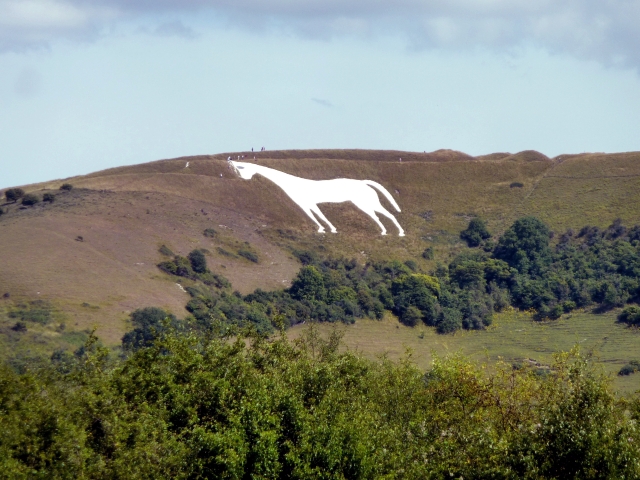 The Westbury or Bratton White Horse is a hill figure on the escarpment of Salisbury Plain, approximately
1.6 miles east of Westbury in England. Located on the edge of Bratton Downs and lying just below an Iron
Age hill fort, it is the oldest of several white horses carved in Wiltshire chalk landscape.
The Westbury or Bratton White Horse is a hill figure on the escarpment of Salisbury Plain, approximately
1.6 miles east of Westbury in England. Located on the edge of Bratton Downs and lying just below an Iron
Age hill fort, it is the oldest of several white horses carved in Wiltshire chalk landscape. -
Wimborne Model Town
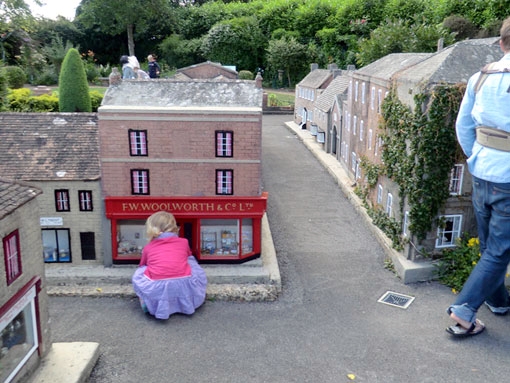 Wimborne Model Town is one of the largest and most established model towns in England. It depicts
the town of Wimborne as it was in the 1950s, and captures the essence of a typical market town of rural
England at that time. The concrete model, built at 1/10 scale, features 120 buildings including 108 shop
fronts. The shop windows accurately show the goods the shops were selling in the post war years.
Wimborne Model Town is one of the largest and most established model towns in England. It depicts
the town of Wimborne as it was in the 1950s, and captures the essence of a typical market town of rural
England at that time. The concrete model, built at 1/10 scale, features 120 buildings including 108 shop
fronts. The shop windows accurately show the goods the shops were selling in the post war years. -
Baiter Park
Historically, Baiter was a narrow peninsula, old maps of the area show a windmill and the town archives refer to a storehouse for gunpowder placed there due to the safe distance from the Old Town. There was also an isolation hospital in use until 1936. At low tide, the outline of the first public swimming pool can be seen. Built in 1890, salt water and tidal, it was replaced by one in Poole Park.
-
Sandbanks Ferry Incident
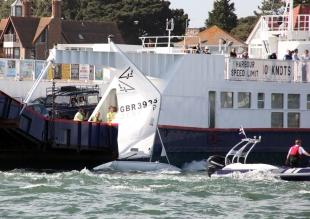 Although the ferry itself has a good safety record, there have been several incidents involving
its passage across the harbour entrance. In 2001, four racing dinghies were pushed into the ferry
by strong currents. One of the boats was sucked under the ferry; two crew members were pulled on
to the ferry, but a 72 year old woman went under with the boat and was rescued after resurfacing on the other side.
Although the ferry itself has a good safety record, there have been several incidents involving
its passage across the harbour entrance. In 2001, four racing dinghies were pushed into the ferry
by strong currents. One of the boats was sucked under the ferry; two crew members were pulled on
to the ferry, but a 72 year old woman went under with the boat and was rescued after resurfacing on the other side. -
Swanage Pier Tramway
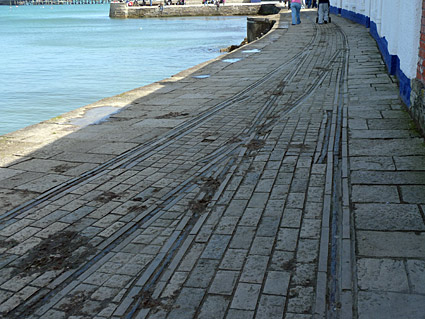 The disused tracks of the Swanage Pier Tramway that once linked nearby stone stores to the original pier
The disused tracks of the Swanage Pier Tramway that once linked nearby stone stores to the original pier
-
Corfe Castle
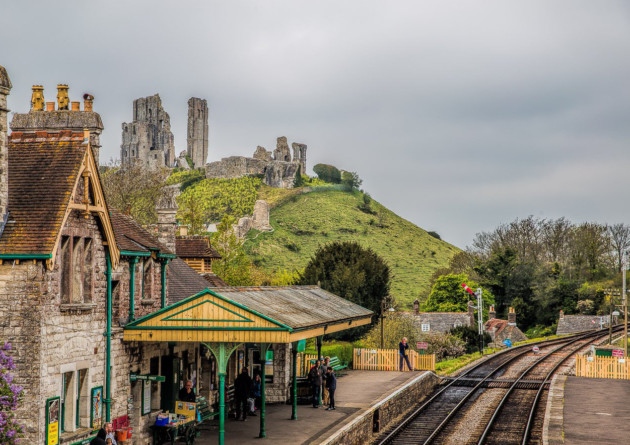 A castle was founded at Corfe on England's south coast soon after the Norman Conquest of England in
1066. The royal forest of Purbeck, was where William the Conqueror enjoyed hunting, this was one of
his hunting lodges. Between 1066 and 1087 William established 36 such castles in England. Sitting as
it does on a hill top, Corfe Castle is one of the classic images of a medieval castle.
A castle was founded at Corfe on England's south coast soon after the Norman Conquest of England in
1066. The royal forest of Purbeck, was where William the Conqueror enjoyed hunting, this was one of
his hunting lodges. Between 1066 and 1087 William established 36 such castles in England. Sitting as
it does on a hill top, Corfe Castle is one of the classic images of a medieval castle. -
Southampton station
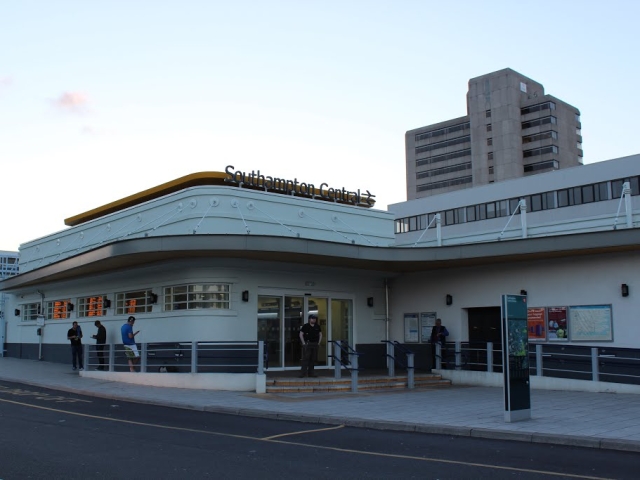 Be careful when you travel between Bournemouth and Southampton, both are major football towns,
during match days you might not get your bike on. Southampton Central station had recently gone through an extensive refurbishment, restoring it’s ‘arte deco’ look. The university had just broken up and the station was packed with students.
Be careful when you travel between Bournemouth and Southampton, both are major football towns,
during match days you might not get your bike on. Southampton Central station had recently gone through an extensive refurbishment, restoring it’s ‘arte deco’ look. The university had just broken up and the station was packed with students.


 According to a survey Bristol is the UK's most bike friendly big city. The accolade for Bristol
came two years after it was named the country's first "cycling city" by the Department for Transport,
giving it access to around £20m in extra funding for bike-related schemes. The city is also the
birthplace of Sustrans, the green cycle route charity which began 30 years ago when volunteers converted
an old rail line between Bristol and Bath into a dedicated bike route.
According to a survey Bristol is the UK's most bike friendly big city. The accolade for Bristol
came two years after it was named the country's first "cycling city" by the Department for Transport,
giving it access to around £20m in extra funding for bike-related schemes. The city is also the
birthplace of Sustrans, the green cycle route charity which began 30 years ago when volunteers converted
an old rail line between Bristol and Bath into a dedicated bike route. The Avon Valley Railway is perhaps best known for connecting the former Somerset and Dorset Joint
Railway (S&DJR), whose northern terminus was at Bath Green Park station, with the London, Midland and
Scottish Railway (LMS). The Midland Railway lines along the Avon Valley thus opened up the S&D lines
to travellers from the British industrial Midlands.
The Avon Valley Railway is perhaps best known for connecting the former Somerset and Dorset Joint
Railway (S&DJR), whose northern terminus was at Bath Green Park station, with the London, Midland and
Scottish Railway (LMS). The Midland Railway lines along the Avon Valley thus opened up the S&D lines
to travellers from the British industrial Midlands. The George Inn in Norton St Philip, Somerset, claims to be Britain’s oldest tavern, it is located
in the centre of the village. Built in the 14th or 15th century and has been designated as a Grade I
listed building. It was originally built as a wool store for Hinton Priory and accommodated merchants
coming to the annual wool fairs.
The George Inn in Norton St Philip, Somerset, claims to be Britain’s oldest tavern, it is located
in the centre of the village. Built in the 14th or 15th century and has been designated as a Grade I
listed building. It was originally built as a wool store for Hinton Priory and accommodated merchants
coming to the annual wool fairs. The Westbury or Bratton White Horse is a hill figure on the escarpment of Salisbury Plain, approximately
1.6 miles east of Westbury in England. Located on the edge of Bratton Downs and lying just below an Iron
Age hill fort, it is the oldest of several white horses carved in Wiltshire chalk landscape.
The Westbury or Bratton White Horse is a hill figure on the escarpment of Salisbury Plain, approximately
1.6 miles east of Westbury in England. Located on the edge of Bratton Downs and lying just below an Iron
Age hill fort, it is the oldest of several white horses carved in Wiltshire chalk landscape. Wimborne Model Town is one of the largest and most established model towns in England. It depicts
the town of Wimborne as it was in the 1950s, and captures the essence of a typical market town of rural
England at that time. The concrete model, built at 1/10 scale, features 120 buildings including 108 shop
fronts. The shop windows accurately show the goods the shops were selling in the post war years.
Wimborne Model Town is one of the largest and most established model towns in England. It depicts
the town of Wimborne as it was in the 1950s, and captures the essence of a typical market town of rural
England at that time. The concrete model, built at 1/10 scale, features 120 buildings including 108 shop
fronts. The shop windows accurately show the goods the shops were selling in the post war years. Although the ferry itself has a good safety record, there have been several incidents involving
its passage across the harbour entrance. In 2001, four racing dinghies were pushed into the ferry
by strong currents. One of the boats was sucked under the ferry; two crew members were pulled on
to the ferry, but a 72 year old woman went under with the boat and was rescued after resurfacing on the other side.
Although the ferry itself has a good safety record, there have been several incidents involving
its passage across the harbour entrance. In 2001, four racing dinghies were pushed into the ferry
by strong currents. One of the boats was sucked under the ferry; two crew members were pulled on
to the ferry, but a 72 year old woman went under with the boat and was rescued after resurfacing on the other side. The disused tracks of the Swanage Pier Tramway that once linked nearby stone stores to the original pier
The disused tracks of the Swanage Pier Tramway that once linked nearby stone stores to the original pier
 A castle was founded at Corfe on England's south coast soon after the Norman Conquest of England in
1066. The royal forest of Purbeck, was where William the Conqueror enjoyed hunting, this was one of
his hunting lodges. Between 1066 and 1087 William established 36 such castles in England. Sitting as
it does on a hill top, Corfe Castle is one of the classic images of a medieval castle.
A castle was founded at Corfe on England's south coast soon after the Norman Conquest of England in
1066. The royal forest of Purbeck, was where William the Conqueror enjoyed hunting, this was one of
his hunting lodges. Between 1066 and 1087 William established 36 such castles in England. Sitting as
it does on a hill top, Corfe Castle is one of the classic images of a medieval castle.